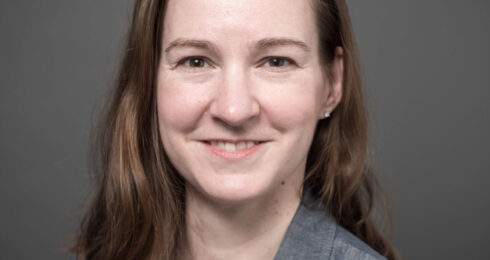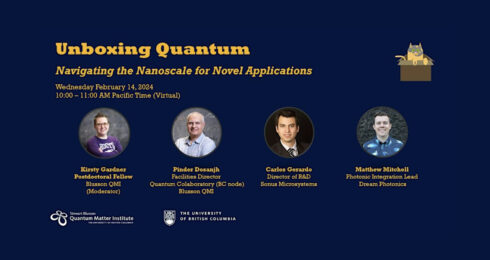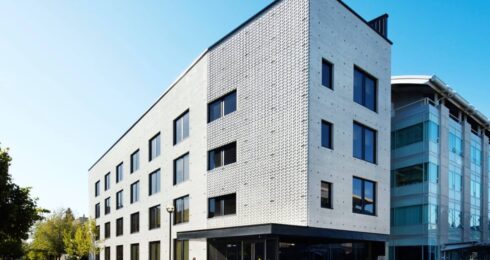“Every crisis is an opportunity,” says Doug Bonn. When the University of British Columbia announced that the majority of classes in Term 1 of the 2020 Winter Session would be taught online, a team of faculty, staff, graduate students, and Quantum Pathways students came together to adapt traditionally in-person first-year physics labs to an online environment. “I had always wanted to develop an online version of my first-year labs, so I took this challenge as a reason to develop a good virtual replica of the in-person experience.”
The Quantum Pathways program at the Stewart Blusson Quantum Matter Institute (Blusson QMI) provides up to four years of research experience to first- and second-year undergraduate students interested in the field of quantum materials. During the summer, students participate in 16-week research positions during which they learn lab and professional skills and participate in collaborative research projects.
“Ordinarily, Quantum Pathways students would be working with Pinder Dosanjh and others at Blusson QMI to learn how to do experiments at low temperatures and how to operate cryogenic equipment,” said Bonn, Professor in UBC’s Department of Physics and Astronomy. “They’d be learning about lab safety and how to conduct research experiments, but with the labs closed we had to adapt very quickly. We wanted to give our Quantum Pathways students meaningful work, and despite the fact that this is not what they expected to be doing, this was an incredible opportunity to have students offer their perspective on classes they had taken themselves relatively recently.”
“To develop good online versions of undergraduate labs, you have to involve undergraduate students,” said Bonn. “Students who have recently been through undergrad labs give you insights you just cannot get from people who are decades past that stage in their lives.”
For Bonn, a pivot to online labs was a natural fit. In 2019, Bonn was awarded the Medal for Lifetime Achievement in Physics by the Canadian Physics Association for his ground-breaking work in quantum materials research but also for his development of innovative approaches to teaching introductory physics laboratories that emphasize students’ ability to reason quantitatively with data, improving learning outcomes for students, rather than simply teaching basic physics concepts. Students in Bonn’s labs conduct physics experiments, but their purpose is to generate data that they then must learn how to work with.
In order to bring these classes into an online environment, Bonn and other faculty met with Quantum Pathways students twice per week throughout the summer in order to conceptualize and design the online program, which students including Luna Liu developed simulations for.
“We really want students to develop a functional understanding of measurement uncertainty and a set of data handling skills,” said Liu, a Quantum Pathways student entering her third year of undergraduate studies in the Department of Physics and Astronomy. “We build uncertainty into the measurements and that element of randomness forces them to estimate what the uncertainty is in order to understand and interpret the data.”
Liu has spent much of the summer programming physics simulations using Javascript and putting her HTML skills to work. For Liu, this has been useful work; her goal is to pursue an academic physics track, and this summer’s work has provided an unusual opportunity to experience planning an academic course and designing curriculum.
“Originally we thought we could simply modify existing simulations, but we realized that to teach the students how to engage with the data, we needed to develop our own tools,” said Liu.
The result is a series of custom simulations developed by students with first-hand experience in first-year physics labs that mimic real-world experiments.
“Students enrolled in these labs run through a sequence of experiments where they learn critical data handling skills; they learn about stats, graphing techniques used in the sciences, and fitting models, which is all at the heart of handling data, comparing data and models; that’s the low-level goal of the course,” said Bonn. “The higher-level goal is to deliver experimental experiences that challenge them – they have to build self-reliance, they have to understand how to go back and fix things, so there’s an iterative cycle built in. If we can replicate that experience online, then we will be successful. And we know we can deliver that online.”
This year, the Quantum Pathways program included eight returning and two new students. Quantum Pathways offers training and support for students from backgrounds that are under-represented in quantum materials research, offering a path to graduate school and careers in physics and quantum technology.
“The impact of COVID-19 presented a huge challenge for supervisors, mentors and students themselves,” said Natalia Bussard, Manager of Programs and Careers, and facilitator for the Quantum Pathways program. “I would like to express a huge thank you to Mona Berciu, Marcel Franz, Doug Bonn, Sarah Burke, Alannah Hallas, Joe Salfi, Meigan Aronson, Alireza Nojeh, Lukas Chrostowski, and Jeff Young for their efforts this summer. In addition, the program could not take place without supervision of excellent graduate student mentors: Mohammad Oudah, Etienne Lantagne-Hurtubise, Rafael Haenel, Amy Qu, Ashley Warner, and Brandon Stuart.”
“Many people are trying to figure out how to do a meaningful online lab, but the leadership on this is really at Blusson QMI; because what we’re doing in our labs is so different, there’s a lot of opportunity to be creative and a lot of expertise among our colleagues we can draw from,” said Bonn. “There are a lot of Blusson QMI feet on the ground, and I’m proud at how we’ve turned a challenging situation into something that’s going to be valuable for a lot of people.”


